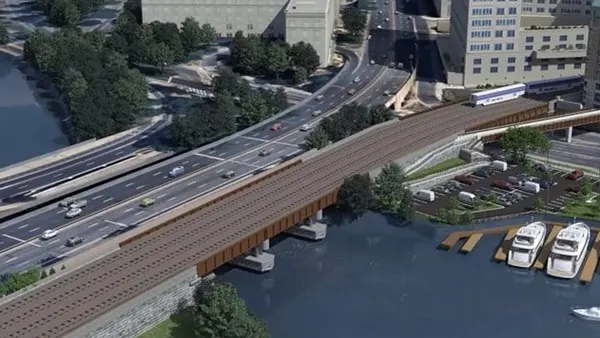Dive Brief:
- According to the latest U.S. Census Bureau figures on the annual rate of construction spending, the country's state and local governments are on track to spend more than $275 billion on nonresidential, taxpayer-funded construction initiatives this year, with highway and street ($93.5 billion), education ($72.5 billion) and transportation projects ($31.7 billion) together garnering the lion's share of funds.
- State and local airport spending has ramped up to an annual rate of $14.5 billion from a November 2011 low of $9.16 billion, according to additional data provided by Governing. Construction of corrections facilities declined the most of any other major spending category in the last decade, from an $8 billion peak in November 2008 to its current level of $4.6 billion, although some of that decline is likely related to the trend toward privatization of prisons and jails.
- Highway and street spending, currently $93.5 billion, has remained relatively flat with only a small peak of $105 billion in January 2016. Spending on primary and secondary schools, which now stands at $46.7 billion, has never returned to its pre-recession highs.
Dive Insight:
If President Donald Trump's $1.5 trillion infrastructure plan, which reportedly has been tabled until after the November midterm elections and possibly until next year, ever sees Congressional approval, state and local governments will be under pressure to come up with even more money to spend on infrastructure projects. The administration has suggested a $200 billion federal investment, with states shouldering the balance of the costs.
To achieve that projected level of spending, many public agencies will have to explore new ways of raising revenue, including increasing their state gas taxes and other motorist fees.
Unlike the federal government, state lawmakers have been more willing to increase fuel taxes, along with other driver-related charges, in order to pay for infrastructure projects. The federal government has not increased federal gas and diesel fuel taxes since 1993, putting the Highway Trust Fund, which allocates gas tax revenue to the states for their surface transportation projects, at risk of insolvency. California, Indiana and Oregon all increased their states' gas taxes, although there is currently a movement underway in California to repeal the 12-cents-per-gallon increase the legislature approved last year to help fund a $52 billion infrastructure initiative.
Earlier this year, when it looked like the president's plan might gain some traction, the U.S. Chamber of Commerce called for a 25-cent-per-gallon increase of gas and diesel taxes to help generate $375 million to pay for it. With a reported lack of Republican support, however, the proposal may have little chance of advancing.













